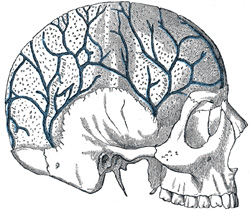| So long as the cranial bones are separable from one another, these veins are confined to the particular bones; but when the sutures are obliterated, they unite with each other, and increase in size. They communicate with the meningeal veins and the sinuses of the dura mater, and with the veins of the pericranium. They consist of (1) the frontal, which opens into the supraorbital vein and the superior sagittal sinus; (2) the anterior temporal, which is confined chiefly to the frontal bone, and opens into the sphenoparietal sinus and into one of the deep temporal veins, through an aperture in the great wing of the sphenoid; (3) the posterior temporal, which is situated in the parietal bone, and ends in the transverse sinus, through an aperture at the mastoid angle of the parietal bone or through the mastoid foramen; and (4) the occipital, the largest of the four, which is confined to the occipital bone, and opens either externally into the occipital vein, or internally into the transverse sinus or into the confluence of the sinuses (torcular Herophili). | 2 |
